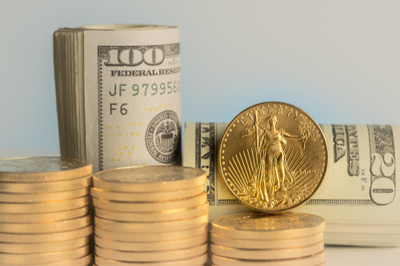The Outlook For Gold
Thomas Puppendahl
 Gold is in a new bull market that began in December 2015, but it has been working through a painfully long, broad-based bottoming phase over the last 2 ½ years. The charts were aligned for a break-out through the $1360 resistance level earlier this year, but the gold price ran out of steam at this critical level several times. Gold is in a new bull market that began in December 2015, but it has been working through a painfully long, broad-based bottoming phase over the last 2 ½ years. The charts were aligned for a break-out through the $1360 resistance level earlier this year, but the gold price ran out of steam at this critical level several times.
The drop below the support at $1220 in July was particularly damaging and led to additional liquidation and a capitulation spike down to $1160, despite an overwhelmingly bullish technical picture. The speculative positioning of Comex traders (COT) is usually a reliable contrarian indicator at turning points, and in fact the COT readings are at an extreme bullish level not seen since the beginning of gold’s last secular bull market in 2001. But when something looks too good to be true, it usually is.
We had been cautious about the strong correlation between gold and the Chinese Yuan since April/May, which seemed to be overriding every bullish argument for gold. For now, it appears that gold is following the Yuan on the way down. The devaluation of the Chinese Yuan could be attributed to the weakening Chinese economy, but was more likely a deliberate response to US tariffs.
Everyone knows that trade wars have no winner, only losers. Rest assured that China will not allow itself to be bullied by the US. Some commentators believe that China will retaliate with a massive 20-30% devaluation of the Yuan, which could mean another drop in the dollar price of gold. However, I do not believe the Chinese would escalate the trade war to such an extent because that would lead to an uncontrollable capital flight out of the Yuan. China can just sit back and wait, because Trump’s trade war is backfiring at home and he will most certainly back off before the US midterm elections in early November.
Also, Trump himself does not want a stronger dollar, although his trade war is the primary cause for the recent strength of the US dollar. It’s actually a joke to be speaking of dollar ‘strength’, considering the out-of-control fiscal situation of the US. But what matters is that, for now, the US dollar is the least weak among the major paper currencies. To some extent, the weakness in gold can be ‘explained’ by the relative strength of the dollar. However, the popular assumption that the gold price is inversely correlated with the US dollar is actually not true. Yes, in the short term gold (and other metals priced in US dollars) tends to move in the opposite direction of the dollar, but longer-term, this correlation is very weak. How otherwise could gold have more than quadrupled over the last 16 years when the dollar index only fell by 25% over the same period?
The Federal Reserve will soon have to reverse course, so the dollar might have peaked already. I think dollar bulls are in for a rude awakening very soon for two reasons. Firstly, Donald Trump doesn’t like a strong dollar, although his policies have been the main driver for the recent dollar strength. Secondly, he doesn’t like the Fed raising interest rates. Now, you might say that Donald Trump doesn’t like a lot of things, but here’s the interesting part: I think the Fed will soon begin to back peddle on the rate rise rhetoric. We all know that the ‘strong US economy’ is a chimera. The only reason why the Fed has been raising rates is because it needs to rebuild some firepower for the next financial crisis. They will raise rates once more in September to preserve whatever little credibility is left, but I suspect the Fed will indicate slowing down any further rate rises.
This comes at a time when gold is about to enter its seasonally strongest period of the year, starting in September. With the speculative Comex gold short positions at the highest level ever recorded, all the necessary ingredients for a short covering rally, and possibly a short squeeze, are in place. There is a perfect storm brewing for gold right now. All the fundamentals are outrageously bullish. Of course, the gold bears will argue that despite years of excessive money printing, the predicted ensuing rise in inflation has not happened, and gold has not even responded to rising geopolitical tensions. This is true, but it doesn’t mean it won’t happen. We are now seeing that monetary inflation is finally beginning to turn into price inflation, as some of the other asset bubbles created by central bank funny money, such as art and real estate, have already started to deflate.
“I do not believe gold mine production has much of an impact on price because gold, unlike commodities that are consumed, has a very large above-ground stock”
Gold bulls typically point to declining mine supply as a bullish argument for gold. It is true that mine production has peaked and is likely to decline for the next couple of years. But I do not believe gold mine production has much of an impact on price because gold, unlike commodities that are consumed, has a very large aboveground stock that is theoretically available for supply – at the right price. This is, in fact, the single most important factor for the gold price. Demand for physical gold (not including the imaginary paper gold created by the bullion banks) has been outstripping ‘supply’ for years. Only the continued liquidation of gold inventories stored in London and other Western vaults, as well as the occasional looting of gold ETF holdings, has prevented the mismatch between supply and demand from driving the gold price much higher.
Once the dollar rolls over and the Fed signals a ‘pause’ (read: ‘end’) to its rate rises, gold will rebound strongly. It remains to be seen if this next rally will be strong enough to push the gold price through $1360, but the longer gold remains suppressed, the more powerful the next move will be.

Thomas Puppendahl is the founder & Chief Investment Officer of Chancery Asset Management, an independent asset management firm based in Singapore. He has over 20 years of experience in financial markets as a Portfolio Manager, Strategist and Analyst. Mr Puppendahl has managed emerging markets sovereign debt, equity and global macro portfolios with a focus on precious metals and mining equities. Prior to setting up Chancery Asset Management, he worked in mergers & acquisitions and asset management with Merrill Lynch, Ermgassen & Co and the Monitor Group in London and Mumbai. Mr Puppendahl holds Master’s degrees in both Physics and Business Administration from RWTH Aachen University, Germany.
www.theassay.com
|




